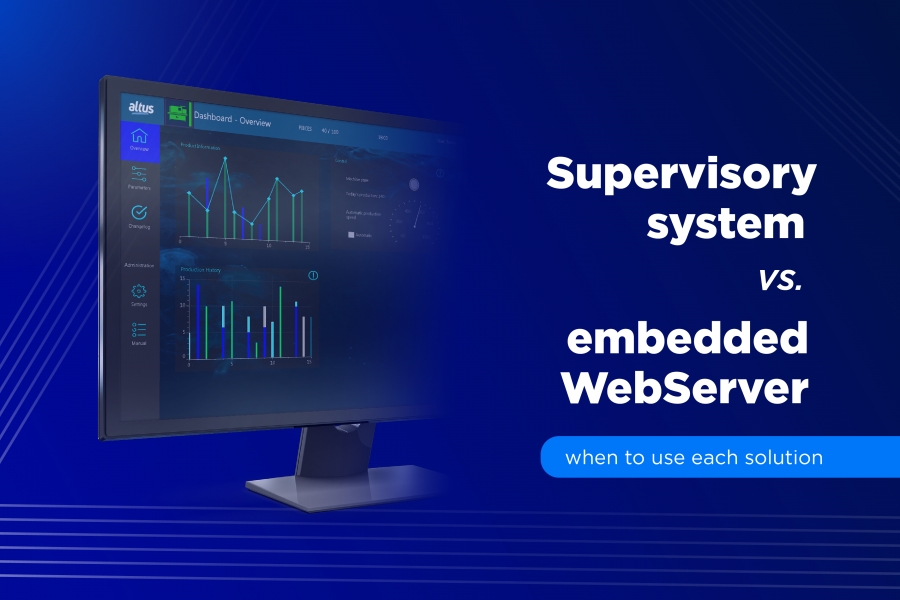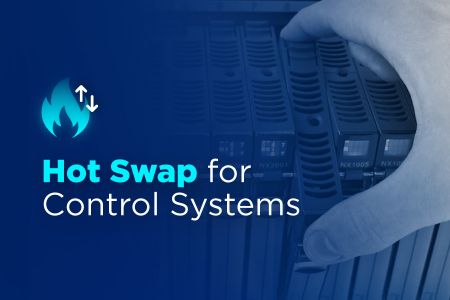
Supervisory system vs. embedded WebServer in PLCs: when to use each solution
Efficiency and reliability are key components for ensuring the seamless operation of various industrial processes. In this context, tools like supervisory systems and WebServers are widely used to enable effective monitoring and control of these processes, each offering unique features and specific use cases.
In this article, we delve into the characteristics, advantages, and limitations of each tool, while also providing practical examples to help you understand when and why to use these solutions. Stay with us through the next few paragraphs as we explore these resources together.
Monitoring and control of automation systems
Welcome to the core of modern industrial operation. As the name suggests, monitoring and control of industrial automation systems involves overseeing and managing equipment and devices. The primary goal is to ensure these resources operate efficiently, safely, and within the planned parameters.
In the industrial sector, the ability to supervise and manage systems goes beyond efficiency — it’s a critical factor for survival in today’s competitive market. Monitoring enables the immediate detection of failures or deviations, while control allows processes to adapt as needed. This synergy helps ensure product quality, minimize waste, and, consequently, reduce operational costs.
This is even more critical in an era where precise data and rapid decision-making are paramount. Over the past few years, monitoring and control have evolved to integrate digital technologies such as IoT (Internet of Things), artificial intelligence, and big data. These advancements enable not only real-time data collection but also predictive analytics and adaptive automation.
There are various ways to implement these systems. In this article, we will explore those we consider the most common and widely used in the industrial market: WebServer and supervisory systems, commonly known as SCADA.
What’s a WebServer?
A WebServer is a technology that enables the creation of monitoring and control interfaces accessible directly through web browsers. Typically embedded in programmable controllers, it eliminates the need for additional software. The core idea behind the WebServer is to simplify access to the various devices that make up an automation system, whether they are on-site or located in a remote area. This concept emerged as a modern and practical solution to meet the demands of an increasingly connected industry.
With a WebServer, the graphical interface is designed using the PLC programming software and then published for remote access. This allows users to view and interact with the system through a browser on a notebook, tablet, or smartphone connected to the network. This flexibility is one of the main advantages of a WebServer system, ensuring that management is not confined to a single location or device.
Advantages and limitations of using a WebServer
The WebServer offers several benefits for industrial operations. The first is accessibility. Since it operates via a web browser, there’s no need to install specialized software, making the process faster and more cost-effective. It also stands out for its low cost, making it an ideal solution for small-scale applications or systems with limited budgets. Another advantage is its ease of use, featuring intuitive interfaces that can be configured relatively easily, even by teams with less technological expertise.
However, the WebServer also has some limitations. Its capacity is constrained, making it unsuitable for large systems or those requiring complex analyses. Additionally, it relies on network infrastructure to function properly. Connectivity issues can disrupt remote access and, consequently, the system’s operation. These limitations make the WebServer better suited for smaller or moderately complex applications.
Common applications for WebServer
Thanks to its low investment cost and ability to be embedded in programmable controllers, the WebServer is commonly used in small-scale applications. In the sanitation sector, for example, it can be applied in pump stations and remote treatment facilities, presenting data collected by the PLC to the system`s operations team. This team may be on-site or located at the company’s Control and Operations Center, ensuring better resource management and efficiency.
The WebServer is also frequently used to control individual machines, especially in small plants where simplicity and cost-effectiveness are essential. In agriculture, it is employed in irrigation systems to remotely control valves and sensors, optimizing water and energy use.
Furthermore, its integration with IoT devices enables automation for residential and commercial solutions, facilitating the creation of smart ecosystems.
What’s a supervisory system?
A Supervisory System, or SCADA, is a robust platform that integrates software and hardware to monitor, manage, and collect real-time data from industrial applications. More than just a supervisory tool, it is a unified solution for complex operations, enabling in-depth analysis and centralized control of large industrial units. In a context where efficiency and integration are paramount, SCADA serves as a cornerstone of modern automation.
SCADA systems rely on a central server that communicates with PLCs, sensors, and other field devices. The collected data is processed and displayed through detailed graphical interfaces, allowing operators to monitor and manage processes in real time.
The system also stores historical data, enabling future analyses and generating detailed reports. One of its main advantages is its ability to interface with various devices and systems, providing a unified view of overall operations.
Advantages and limitations of using a supervisory system
SCADA systems are highly scalable, capable of managing both small applications and large industrial operations distributed across multiple locations. They enable advanced analyses, supporting big data utilization, historical reporting, and even predictions powered by artificial intelligence algorithms. Additionally, SCADA offers a high degree of customization, allowing it to adapt to the specific needs of each application.
Despite its advantages, SCADA also comes with challenges. One of the main drawbacks is its high cost, primarily due to the infrastructure required for its implementation. Furthermore, its installation, maintenance, and operation can be complex, requiring a specialized team, which may pose a barrier for smaller companies. These attributes make SCADA a more suitable choice for large-scale or high-criticality applications.
Common applications for supervisory systems
SCADA systems are widely used across various industrial sectors. In agribusiness, they enable the monitoring and control of the entire production chain, from irrigation to food processing. In urban applications, SCADA systems are employed in traffic management, overseeing traffic lights and vehicle flow sensors.
In the energy sector, SCADA supervises turbines, generators, and distribution networks, ensuring the reliability and efficiency of energy supply. In metallurgy, it controls furnaces, conveyors, and other equipment, optimizing complex industrial processes and improving the quality of the final product.
Key differences between supervisory systems and WebServers:
- Complexity: The WebServer is simple to configure and operate, while SCADA is designed to handle complex and large-scale industrial systems.
- Cost: The WebServer is a more affordable solution, ideal for small-scale applications. In contrast, SCADA requires a higher initial investment due to the necessary infrastructure.
- Scope: The WebServer is limited to local or small-scale applications, whereas SCADA can supervise operations across multiple locations.
- Customization: SCADA systems offer a high degree of customization, whereas the WebServer features more standardized functionalities.
- Infrastructure: The WebServer requires only a device with a browser and network connection, while SCADA demands servers, workstations, and dedicated networks.
Altus PLC with embedded WebServer
In addition to robust hardware with high processing performance, the Nexto Series PLCs feature a range of software tools designed to enhance the user experience with Altus technology. Among these tools is the WebServer, a feature that allows users to create supervision and monitoring screens for applications without the need for a SCADA system.
Available on the NX3008, NX3005 CPUs, and the XP340 PLC, the WebServer is embedded in the programmable controller’s memory and can be accessed via the web browser of any device (computer, tablet, or smartphone) connected to the network. In addition to enabling remote system control, this functionality represents a significant cost-saving for projects by eliminating the need for dedicated supervision equipment and software.
To help you make the most of your CPU, we’ve created a step-by-step tutorial on how to build a web visualization using the embedded features of the NX3005 and XP340.
Control and supervision solution with SCADA BluePlant
BluePlant is a solution for supervision, control, and data acquisition that offers advanced design and programming features, delivering a unique experience for both designers and operators.
The software boasts an attractive and intuitive interface, client-server architecture with various communication tag options, as well as a simulator and debugging tools. Flexible and highly customizable, Altus` platform stands out as a versatile solution for processes across a wide range of industries, including building automation, agribusiness, food processing, sanitation, transportation, and general industry.




